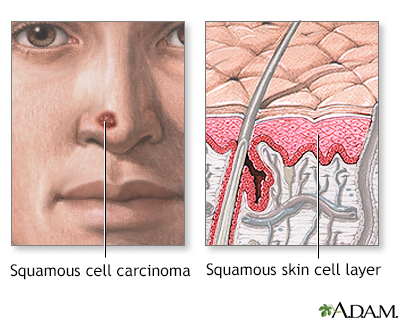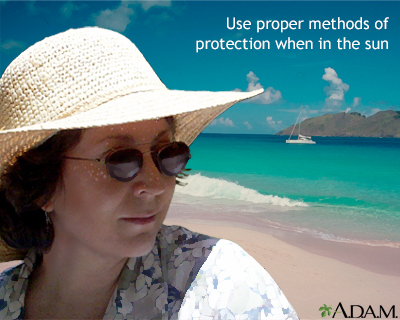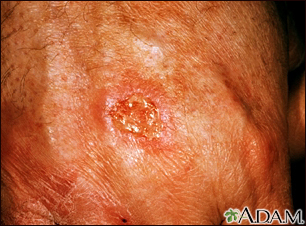Protect the Skin You’re In
Soaking up the sun can feel harmless, but when we're caught up in the fun, many people forget to consider the negative effects the sun can have on their skin.

Update your location to show providers, locations, and services closest to you.
Squamous cell cancer is the second most common type of cancer in the United States.
Other common types of skin cancer are:

Cancer - skin - squamous cell; Skin cancer - squamous cell; Nonmelanoma skin cancer - squamous cell; NMSC - squamous cell; Squamous cell skin cancer; Squamous cell carcinoma of the skin
Squamous cell skin cancer affects the epidermis, the top layer of skin.
Squamous cell cancer may occur in undamaged skin. It can also occur in skin that has been injured or inflamed. Most squamous cell cancers occur on skin that is regularly exposed to sunlight or other ultraviolet radiation.
The earliest form of squamous cell cancer is called Bowen disease (or squamous cell carcinoma in situ). This type does not spread to nearby tissues, because it is still in the outermost layer of the skin.
Actinic keratosis is a precancerous skin lesion that may become a squamous cell cancer. (A lesion is a problem area of the skin.)
A keratoacanthoma is a mild type of squamous cell cancer that grows rapidly.
Risks of squamous cell cancer include:
Squamous cell cancer usually occurs on the face, ears, neck, hands, or arms. It may occur on other areas.
The main symptom is a growing bump that may have a rough, scaly surface and flat reddish patches.
The earliest form (squamous cell carcinoma in situ) can appear as a scaly, crusted, and large reddish patch that can be larger than 1 inch (2.5 centimeters).
A sore that does not heal can be a sign of squamous cell cancer. Any change in an existing wart, mole, or other skin lesion could be a sign of skin cancer.
Your doctor will check your skin and look at the size, shape, color, and texture of any suspicious areas.
If your doctor thinks you might have skin cancer, a piece of skin will be removed. This is called a skin biopsy. The sample is sent to a lab for examination under a microscope.
A skin biopsy must be done to confirm squamous cell skin cancer or other skin cancers.
Treatment depends on the size and location of the skin cancer, how far it has spread, and your overall health. Some squamous cell skin cancers may be more difficult to treat.
Treatment may involve:
You can ease the stress of illness by joining a cancer support group. Sharing with others who have common experiences and problems can help you not feel alone.
How well a person does depends on many things, including how soon the cancer was diagnosed, the location, and whether or not you have a weakened immune system. Most of these cancers are cured when treated early.
Some squamous cell cancers may return. There is also a risk that squamous cell skin cancer may spread to other parts of the body.
Contact your health care provider for an appointment if you have a sore or spot on your skin that changes in:
Also contact your provider if a spot becomes painful or swollen or if it starts to bleed or itch.
The American Cancer Society recommends that a provider examine your skin every year if you are older than 40 and every 3 years if you are 20 to 40 years old. If you have had skin cancer, you should have regular checkups so that a doctor can examine your skin.
You should also check your own skin once a month. Use a hand mirror for hard-to-see places. Call your doctor if you notice anything unusual.
The best way to prevent skin cancer is to reduce your exposure to sunlight. Always use sunscreen:
Other measures to help you avoid too much sun exposure:










Dinulos JGH. Premalignant and malignant nonmelanoma skin tumors. In: Dinulos JGH, ed. Habif's Clinical Dermatology. 7th ed. Philadelphia, PA: Elsevier; 2021:chap 21.
National Cancer Institute website. Skin cancer treatment (PDQ) - Health Professional Version. www.cancer.gov/types/skin/hp/skin-treatment-pdq#section/_222. Updated February 11, 2022. Accessed April 14, 2022.
National Comprehensive Cancer Network website. NCCN Clinical Practice Guidelines in Oncology (NCCN Guidelines): Basal cell skin cancer. Version 2.2022. www.nccn.org/professionals/physician_gls/pdf/nmsc.pdf. Updated March 24, 2022. Accessed April 14, 2022.
US Preventive Services Task Force, Bibbins-Domingo K, Grossman DC, et al. Screening for skin cancer: US Preventive Services Task Force recommendation statement. JAMA. 2016;316:(4)429-435. PMID: 27458948 pubmed.ncbi.nlm.nih.gov/27458948/.





Our community and patient programs provide great value to patients, families and loved ones. People can find support, educational materials, expert consultants and more. In most instances, these programs are offered free of charge.
Improves health and quality of life for long-term cancer survivors.
An educational and networking event that brings together cancer patients, survivors, caregivers and health care professionals.
Pain management treatment plans for cancer patients.
Helps individuals access high-quality cancer screening, prevention and treatment services.
Can assist you through the treatment process in a number of practical and supportive ways.
Soaking up the sun can feel harmless, but when we're caught up in the fun, many people forget to consider the negative effects the sun can have on their skin.

When the sun comes out, so does the skin. In warmer weather, people of all ages hit the beach, the park and the other places for fun in the sun. With more time…
